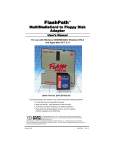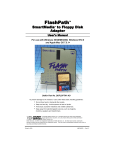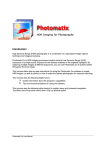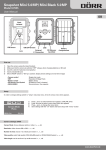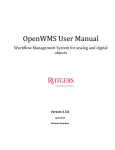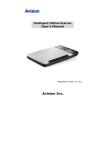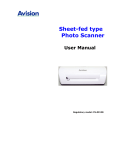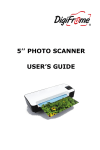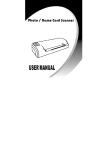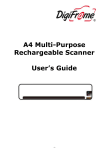Download Digi-Frame Photo Scanner User guide
Transcript
Photo Scanner User Guide What’s in the Box Check the package for the following items. If there are any items missing or damaged, please contact your place of purchase immediately. Scanner AC Power Adapter CD containing User Guide Scan To PC software (on CD) Calibration Card Roller Cleaning Tool Sensor Cleaning Swab 2 x Plastic Sheaths USB Cable Supported Memory Cards SD / SDHC / MMC PC System Requirements Operating system: Windows XP, Vista, Windows 7 (32 / 64 bit or later version) USB Port Supported: USB 2.0 port 10MB free hard disk space for the Scan To PC Manager software 1 Table of Contents 1. Introduction ....................................................................................3 2. Scanner Overview .........................................................................4 3. Installation & Operation .............................................................5 3.1 3.2 3.3 3.4 4. Connecting to a Computer .......................................................10 4.1 4.2 5. Cleaning the Roller ............................................... 14 Calibrating the scanner ......................................... 15 Cleaning the Image Sensor.................................... 16 Troubleshooting ...........................................................................17 7.1 8. Starting the Scan To PC Utility ............................... 12 Uninstalling the Scan To PC Manager ...................... 13 Maintenance ..................................................................................14 6.1 6.2 6.3 7. How to connect to a computer................................ 10 Disconnecting the scanner from a computer ............. 11 Scanning To PC Manager ..........................................................12 5.1 5.2 6. Initial Setup .......................................................... 5 Power on the Scanner ............................................. 6 Scan an Original .................................................... 7 Power off the Scanner............................................. 8 Frequently asked Questions ................................... 17 Specifications ................................................................................18 2 1. Introduction Congratulations on your purchase of a DigiFrame Photo Scanner. Now you can scan and store your printed photos directly to your memory card or USB Stick without connecting to any computer. Simply insert a memory card or USB into the scanner, and power it on. When the scanner is ready, feed your printed photo into the scanner and your images will be stored in the memory card or USB. If you want to store your photos directly into your computer, just plug in a USB cable and/or use the supplied Scan To PC utility. Before you install and operate the product, please take a few minutes to read through this manual. It provides proper instructions for you to install, operate and maintain the product. 3 2. Scanner Overview Name Function/ Description 1 Power Button Press to power on or off. 2 Custom Button Press the button to start cleaning the roller. 3 Guide Lever Slide the guide lever to adjust for various sized originals to ensure the proper alignment. 4 Indicator light Indicates the operating status of the scanner. 5 Feeding Slot Insert an original to begin scanning. 6 Power connector For connecting to the supplied power adapter. 7 Mini USB connector For connecting to a computer via a USB cable. 8 Flash disk slot For inserting a USB Stick. 9 Memory card slot For inserting a memory card. 4 3. Installation & Operation Precautions Keep the product out of direct sunlight. Direct exposure to the sun or excessive heat may cause damage to the unit. Do not install the product in a humid or dusty place. Be sure to use the proper AC power source. Place the product securely on an even, flat surface. Tilted or uneven surfaces may cause mechanical or paper-feeding problems. Retain the product box and packing materials for shipping purposes. 3.1 Initial Setup 1. Connect the plug on the power adapter cable to the power connector on the scanner. 2. Plug the power adapter into a power outlet. 3. Insert a memory card into the memory card slot or a USB into the USB slot. 5 3.2 Power on the Scanner 1. Press and hold the Power button for about 1 second. The power indicator light blinks. 2. Wait until the power indicator stops blinking and stays on steady indicating the scanner is ready. The indicator light patterns represent function status as follows: Light Steadily on Description The scanner is ready for use. Blinks continuously Initializing system and memory card. Please wait until the initialization process is complete before using the scanner. Busy scanning and storing image files. Please wait until the process is complete before scanning another original. Sensor cleaning in progress. Please wait until the process is complete before performing any operations. 2 Blinks Paper jam. Press the Power button for about 0.5 seconds; the scanner will back out the original so you can remove it from the input slot. 3 Blinks Memory card error. Remove the memory card to clear this error status. 4 Blinks Calibration failed. Error indication only. 5 Blinks Scan To PC failed. The PC may be busy or unavailable. No light The scanner is powered off. 6 3.3 Scan an Original 1. Insert your photo into the plastic sheath supplied with scanner. (The detailed usage of the plastic sheath is described in the next page.) 2. With the side to be scanned facing upward and in correct orientation (bottom of photo against light/power button side), place the left edge of the original against the left edge of the feed slot, and then adjust the guide lever so that it is against the right side of the original. 3. Gently push the original into the feeding slot and let go when it begins to feed into the slot. 4. When the scan is completed, the scanner will automatically create a folder titled “Photo1” on your memory card or flash card, which will hold the first 9999 scans. Then “Photo2” folder will be created for the next 9999 scans, and so on. (Each scanned image is given a file name with the prefix img followed by a 4- digit sequential number in the order the images are stored. For example, img0001.jpg, img0002.jpg, etc.) Note: z Do not remove the memory card or disconnect the power supply while the indicators are blinking. z This scanner only supports output images in JPEG (.jpg) format, and the date/ time attribute will not be added. z If the memory card is near full (lower than 1MB), the power indicator light blinks. Use another card or delete some files on it if necessary. z Insert only one original at a time, and insert the next original only when the previous one is done and the blinking has stopped, otherwise the scanner may malfunction. 7 Plastic Sheaths Use the clear plastic sheath (included) when scanning photos to ensure the best scanning results. The sheath helps eliminate the possibility of de-focusing due to the uneven surface of curled photos. Curled photo Fuzzy areas that result from the uneven surface of the curled photo 1. Insert the photo into the plastic sheath as shown below. 2. Insert the plastic sheath, flat and level, into the scanner’s feeding slot, folded side first, image facing up. Note: z Keeping the original flat and level when feeding prevents possible jamming. z Keep originals free from finger prints, oil, dirt, and dust for optimum scanned image quality. z Remove photos from the plastic sheath after scanning to prevent the sheath from sticking to the photos over time. z If the plastic sheaths are not in use, store them in a safe place and keep them protected from accumulating dust. 3.4 Power off the Scanner After all originals are scanned, press and hold the power button for about 2 seconds. Now you can safely disconnect the power and remove the memory card or flash card from the scanner. 8 Important: (1) Insert only one photo at a time, and insert the next one only when the previous one is done. Otherwise, the scanner may malfunction. (2) The acceptable paper size is 2”x 2” ~ 4” x 6” (3) DO NOT use the following types of originals for scanning; otherwise the scanner may malfunction or cause the original to jam in the slot. • Originals thicker than 0.5mm • Originals with either side shorter than 55mm • Originals with lots of black or dark colors • Originals with dark colors surrounding the edges • Transparencies (filmstrips, celluloid, etc.) • Printed images (pictures on newspapers, magazines, etc.) • Soft and thin materials (thin paper, cloth, etc.) • Originals that exceed the acceptable size (4) The scanner has a built-in cropping function that is capable to detect and crop the edges of an original. The max cropping size is 1.5mm per edge, as illustrated below: (5) If the photo is incorrectly/angled into the slot, the four edges of the scanned image will become dark as illustrated. 9 4. Connecting to a Computer By connecting the scanner to a computer, you can access the scanned images on the memory card directly, or use the scanner as a memory card reader, so that you can freely copy, paste or delete files to and from the memory card using the computer. 4.1 How to connect to a computer 1. Insert a memory card or flash disk containing your scanned images into the memory card slot. 2. Connect the mini end of the USB cable (included with scanner) to the Mini USB connector on the scanner. 3. When the scanner connects successfully with a computer, a Removable Disk (F) (F represents the removable drive letter) will be shown in Windows Explorer. If a memory card or flash disk is inserted to the scanner, the Removable Disk will be replaced with the name of the memory card or USB. 4. You can now view or edit the files on the memory card or flash disk using your own graphic editing software. 10 4.2 Disconnecting the scanner from a computer 1. On the Windows System Tray, click the hardware removal icon. 2. Click the ‘Safely remove USB mass Storage device’ message with the corresponding Drive. 3. When the ‘Safe to Remove Hardware’ message appears, you can safely remove the scan engine’s USB cable. 11 5. Scanning To PC Manager With the Scan To PC Manager, you can easily scan photos and save the scanned images directly to the connected PC. You can also choose the location where the scanned images will be saved. 5.1 Starting the Scan To PC Utility 1. Connect the scanner to your computer with a USB cable. If successfully installed, a Removable Disk (F) (F represents the removable drive letter) will be shown in the Windows Explorer. If a memory card is inserted to the scanner, the Removable Disk will be replaced with the name of the memory card. 2. Insert the Scan To PC CD provided and Double click on Setup.exe. Now, the Scan To PC Utility runs, and the icon system tray. OR as an Icon on your Desktop. stays on the 3. in the system tray and select SETTING (or Right click the icon Double Click on the Desktop Icon) to Open the Scan To PC Utility screen, as shown below: 4. To save the scanned images to your computer, select Scan To PC in the drop-down menu of Save Type. To save the scanned images to your memory card connected to the scanner, select Memory Card in the drop-down menu of Save Type. Important: Once you have installed the Scan To PC Utility and you wish to save your scanned images to a memory card, you still need to use Scan To PC Utility and select Memory Card in the drop-down menu of Save Type. 5. Click the Browse button to save your scanned images to a specified location. (Default is C:\temp\) 6. Click Apply to save the settings or Cancel to leave the Setting screen without saving the changes. Note the Scan to PC Utility icon is still running in your system tray. 12 7. Scan your photo described. After your scan, a folder titled Photo1 to save the scanned images is added to a default or specified location. Note each scanned image is given a file name with the prefix img followed by a 4-digit sequential number. For example, img0001.jpg, img0002.jpg. 8. To exit the Scan To PC Utility, right-click the icon tray and select Exit. in the system Note: z If you have not inserted a memory card to the scanner engine, a Removable Disk drive will still be shown in Explorer window though you can not access anything from the drive. z If you have inserted a memory card to the scanner engine, the name of the memory card will be shown in Explorer window. 5.2 Uninstalling the Scan To PC Manager 1. From the PC Start menu, select: All Programs > Scan To PC > Uninstall Driver 2. Follow the uninstall wizard to uninstall the software. 3. Restart your PC when prompted to do so. 13 6. Maintenance 6.1 Cleaning the Roller 1. Clean the scanner’s outer casing first, using only the recommended and supplied tools. 2. Connect the power supply to the scanner. 3. Press and hold the power button for about 0.5 seconds to power the scanner on. 4. 5. Insert SD card or USB device, then the light turn green. Please hold the Custom button about 0.5 seconds. 14 6. Place the supplied roller cleaning tool on the feeding slot. The cleaning tool will be brought into the feeding slot automatically, and the cleaning process will begin. 7. When the cleaning process is completed, the cleaning tool will be ejected from the feeding slot automatically. 6.2 Calibrating the scanner If the scanned image looks fuzzy or there are strange stripes on it, the scan engine may need calibrating in order for the sensor to resume its original precision. To calibrate the scan engine: 1. Follow the instructions of Cleaning the Roller on the preceding section to clean the roller. 2. Press the Custom button for about 0.5 seconds, and then the indicator LED blinks in green. 3. Insert the calibration chart to the feed slot in 3 seconds. 4. The scanner starts calibrating. 15 6.3 1. 2. 3. 4. Cleaning the Image Sensor Clean the scanner’s outer casing first, using only the recommended and supplied tools. please turn the power off first then take the adaptor off, place the supplied senor cleaning tool on the feeding slot。 Put the cleaning from one side to other side lightly and repeat it 5 or 6 times. Take the cleaning tool out of scanner and store it to clean place. 16 7. Troubleshooting If you have problems with the operation of the product, please check the following troubleshooting hints. 7.1 Frequently asked Questions Question: Answer: There are strange lines on the scanned image, or the image is not clear. Check the following: Are there scratches on the original, or is the original clean? Remove any stains or dust from the original before scanning. Has the scanner been used for a long period of time without cleaning and calibration? Follow the instructions for "Cleaning the Scanner" and “Calibrating the Scanner", and then try again. Question: The original gets stuck halfway in the feeding slot. Answer: Press the Power button. The scanner will back out the original so you can remove the jammed original from the output slot. Question: The status indicator blinks rapidly and no scan is possible. Answer: Check the following: Is the memory card inserted properly into the memory card slot? Re-insert the card and try again. Is the SD card locked (set to write-protect)? Unlock the card. Is the memory card full? The indicator blinks when the free space on the memory card is below 1MB. Use another card if necessary. Make sure the memory cards are in FAT or FAT32 file formats only, not NTFS or any other file format. Did you insert the next original before the scanning process of the previous one was completed? Power the scanner off and back on and try again. Make sure that you scan the next original only after the scanning process of the previous one has completed. Does the length of the original exceed the maximum acceptable size? 17 Question: The scanner feels warm to the touch. Answer: It is normal for the scanner to emit a small amount of heat (around 30-45 Celsius) after prolonged use. However, if there are strange odors coming from the scanner or the scanner feels hot to the touch, disconnect the scanner immediately from the power supply or the computer. 8. Specifications All specifications are subject to change without notice. Specification Sheet-fed type Photo Scanner Acceptable paper size 2”x 2” ~ 4” x 6” Output image formats JPEG with compression Memory Resolution Color Flash 512KB Internal 64MB (DDRI) Scanned image 300 dpi (dots per inch) Optical 1200 dpi (dots per inch) Scan color depth Color – 48 bit Output format Color – 24 bit (JPEG) Memory Cards SD / SDHC / MMC USB Mini USB port compatible with the USB 2.0 / 1.1 Device specification Interfaces USB Mass Storage Supported Power Windows XP/Vista/7 Input 100-240W Output 5V, 1.5A Photo feeding Sheet feed type Recommended Operating Environment 5oC ~ 35oC (41oF~95oF); 20% RH ~ 70% RH 18




















